
In the first post of this series, I explained the chief downsides of lead acid batteries, the type found powering the house bank in 99.999% of all RV’s you have ever seen.
It is a depressingly long list.
As you will soon see, on paper lithium ion batteries seem to be superior in almost every possible way – as if Zeus himself had climbed down from Olympus and handed the world the perfect battery. Or maybe it wasn’t Zeus, but that annoying pink Energizer Bunny, bringing the gift of divine electrons pulsing to the rhythm of his eternal drum.
To understand the promise and potential of lithium ion batteries for RV use, it helps to first understand the myriad of ways that lithium ion batteries differ from lead acid.
The Lithium Difference
Lead acid batteries are made from (not surprisingly) a mixture of lead plates and sulfuric acid. This was the first type of rechargeable battery, invented way back in 1859.
Lithium ion batteries on the other hand are a much newer invention, and have only been around in a commercially viable form since the 1980’s.
Lithium technology has become well proven and understood for powering small electronics like laptops or cordless tools, and has become increasingly common in these applications – edging out the older NiCad (Nickel-Cadmium) rechargeable battery chemistry due to lithium’s many advantages.
But as you might recall from the many news stories a few years ago around defective laptop batteries bursting into flame – lithium ion batteries also earned a reputation for catching fire in a very dramatic fashion. The commonly used lithium ion battery formulation had been Lithium-Cobalt-Oxide (LiCoO2), and this battery chemistry is prone to thermal runaway if the battery is ever accidentally overcharged. This could lead to the battery setting itself on fire – and a lithium fire burns hot and fast.
Just imagine how nasty the fire would be if it was a large battery burning, and not just a small laptop battery!
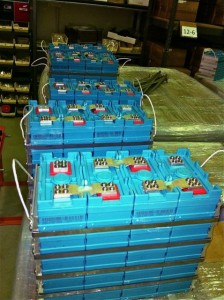
This is one of the reasons that up until recently, lithium was rarely used to create large battery banks.
But in 1996 a new formula for mixing lithium ion batteries was developed – Lithium Iron Phosphate. Known as LiFePO4 or LFP, these batteries have a slightly lower energy density but are intrinsically non-combustable, and thus vastly safer than Lithium-Cobalt-Oxide.
Now that large scale LFP batteries are starting to be massed produced (primarily targeting the electric vehicle market), we are now on the cusp of LFP batteries becoming practical for RV use!
And once you consider the advantages, LFP batteries becomes exceedingly tempting.
Consider…
The Amazing Advantages of Lithium Ion Batteries
To understand just how substantial these advantages are, be sure to read the parallel list about the downsides of lead acid batteries…
Superior ”Useable” Capacity
Unlike with lead acid batteries, it is considered practical to regularly use 80% or more of the rated capacity of a lithium battery bank, and occasionally more. Consider a 100 amp hour battery – if it was lead acid you would be wise to use just 30 to 50 amp hours of juice, but with lithium you could tap into 80 amp hours or more.
Extended Cycle Life
Laboratory results indicate that you could expect to see 2,000 to 5,000 cycles out of a well cared for LiFePO4 battery bank, which means that a lithium ion battery bank has the potential to likely outlast your RV! These are theoretical results – we are looking forward to seeing how lithiums do in reality for RV use, as the energy uses of a home-on-wheels is not normal laboratory conditions, nor at all similar to that of an electric vehicle (which is where LFP is primarily used right now).
In contrast, even the best deep cycle lead acid batteries are typically only good for 500-1000 cycles.
Fast & Efficient Charging
LiFePO4 batteries can be ”fast” charged to 100% of capacity. Unlike with lead acid, there is no need for an absorption phase to get the final 20% stored. This can save you hours of generator run time. And, if your charger is powerful enough, lithium batteries can also be charged insanely fast. If you can provide enough charging amps – you can actually fully charge a lithium ion battery just 20 minutes!
But even if you don’t manage to fully top off to 100%, no worries – unlike with lead acid, a failure to regularly fully charge LFP batteries does not damage the batteries.
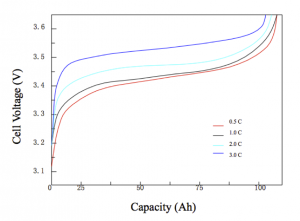
This give you lots of flexibility to tap into energy sources whenever you can get them without worrying about needing to do a full charge regularly. Several partly cloudy days with your solar system? No problem that you can’t top off before the sun goes down, as long as you’re keeping on top of your needs. Only 30 minutes left until quiet time at the primitive campground? No worries – with lithium, you can charge up what you can and not fret about leaving your battery bank perpetually undercharged!
Very Little Wasted Energy
Lead acid batteries are less efficient at storing power than lithium ion batteries. Lithium batteries charge at nearly 100% efficiency, compared to the 85% efficiency of most lead acid batteries.
This can be especially important when charging via solar, when you are trying to squeeze as much efficiency out of every amp as possible before the sun goes down or gets covered up by clouds. Theoretically, with lithium nearly every drop of sun you’re able to collect goes into your batteries. With limited roof & storage space on RVs for panels, this become very important in optimizing every square inch of wattage you’re able to mount.
Especially combined with the fast charging ability, this also translates to less fuel costs when running your generator to charge the batteries.
Fewer Placement Issues
LiFePO4 batteries do not need to be stored upright, or in a vented battery compartment. They can also fairly easily be assembled into odd shapes – an advantage if you are trying to squeeze as much power as possible into a small compartment. This is especially useful if you have an existing battery bay that is limited in size, but you want or need more capacity than lead acid is currently able to provide.
Little Maintenance Requirements
Theoretically, lithium batteries should be fairly maintenance free. An occasional “balancing” process to make sure all the cells in a battery bank are equally charged may be called for, but a well designed energy management system should (ideally) do this automatically.
But to be fair, while we are in the experimental phase with our own lithium battery system, they are far from maintenance free as we endeavor to tweak the system. Until we perfect our setup, we are watching our batteries vigilantly.Remember, this is newer technology and barely even tested for RV use. Inverters and chargers do not yet come standard with profiles for LFP. The battery distributors and manufacturers are still tweaking the energy management systems that protects the batteries too. This is new and evolving tech, and not quite yet ready to be “plug and go”.
AGMs have an advantage here, just set your charger to “AGM Mode” and you are good to go.
Peukert’s Losses & Voltage Sag Virtually Non Existant
The discharge curve of lithium batteries (especially relative to lead acid) is essentially flat – meaning that a 20% charged battery will be providing nearly the same output voltage as an 80% charged battery. This prevents any issues caused by the “voltage sag” common to lead acid as they discharge, but does mean that any battery monitor or generator auto-start dependent upon voltage levels will likely not work well at all when monitoring a lithium bank.
On the flip side, once lithium batteries are fully discharged, their voltage takes a nose-dive quickly – which is why tweaking your energy management systems to protect the batteries to absolutely never let this happen is vitally important. Completely discharging a lithium ion bank, even once, can render your entire pack permanently dead.
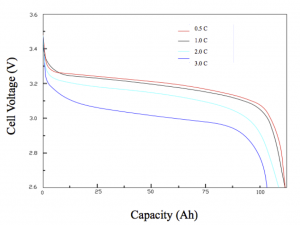
Another huge advantage of lithium batteries is that Peukert’s losses are essentially non-existant. This means that LiFePO4 batteries can deliver their full rated capacity, even at high currents. Whereas lead acid can see as much as a 40% loss of capacity at high loads. In practice, this means that LFP battery banks are very well suited to powering high current loads like an air conditioner, a microwave or an induction cooktop.
Size & Weight Advantages
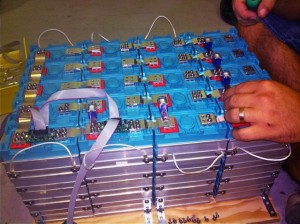
And finally, the reason why most folks are intrigued by lithium… LFP batteries are much smaller & lighter!!!
The 12-volt 100 Amp Hour LiFePO4 battery packs we started with when building our system are 4.9″ x 11.0″ x 9.2″, and weigh just 28.2 lbs. That works out to be 0.282 lbs per amp hour of capacity.
A Trojan 8D-AGM 230 amp hour battery on the other hand weighs 167lbs, which works out to be .726 lbs per amp hour – which is about 2.5 times heavier.
And when you take “usable” capacity into account, the weight advantage of lithium is even more dramatic. Remember, that 100 amp hours of lithium will deliver 80 amp hours, no matter the discharge rate, without worry. 230 amp hours of AGM can only deliver 70- 115 amp hours, depending on the discharge rate.
So not only is lithium smaller and lighter than AGM per amp hour, you need significantly less stored amps to get the same usable capacity.
To simplify what we’ve covered so far about Lithium Ion vs. Lead Acid AGMs, here’s this handy chart we created:
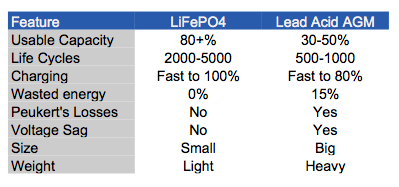
As you’ve seen, the theoretical advantages of LiFePO4 batteries for RV use are exceedingly compelling, particularly if you boondock a lot, use solar and/or want to minimize generator use. But we all should remember about the difference between theory and practice…
In theory, there is no difference.
In practice – using LiFePO4 for RV house batteries remains new and uncharted waters.
And that brings us to the biggest downsides of lithium batteries – the cost and the novelty.
These uncharted waters don’t have a low cost of entry, particularly when compared to the Walmart specials on generic flooded lead acid batteries. And there are not a lot of resources you can turn to for tech support since the technology is so new. Most inverter / charger makers don’t even officially support lithium batteries yet at all. So those opting to try lithium for RV use are pioneers, and need to educate themselves to fully understand what they are dealing with.
But…
If you consider the lifetime cost, and the fact that lithium batteries should (theoretically) far outlast even the best high-end AGM’s, suddenly the math starts to look compelling.
I’ll dive into explaining how we weighed the lifetime costs vs the benefits, and will give the details on the costs and specifics of our new system in my next lithium post. Stay tuned!
By the way, we should note – we are not trying to motivate anyone to follow us on this path. We are not selling these batteries, we are not affiliates with any battery dealer, we paid for all our components and nor do we have any financial stake in the technology beyond our own systems. We are simply full time RVing technomads who are designing our own cutting edge home & office on wheels, and are sharing our research & project. Of course we’d love to have more folks out there pioneering and helping us take the arrows in our backs. Right now, we do not consider this technology ready for the mainstream, and those contemplating this technology need to be a bit savvy with electrical and battery technology.
Other Posts In this Series:
Promise of Lithium #1: Lead Acid Battery Downsides
Promise of Lithium #3: Lithium RV Battery System Cost Analysis
A Year on Lithium (The One Year Follow-Up)
All our Lithium Ion Battery Posts

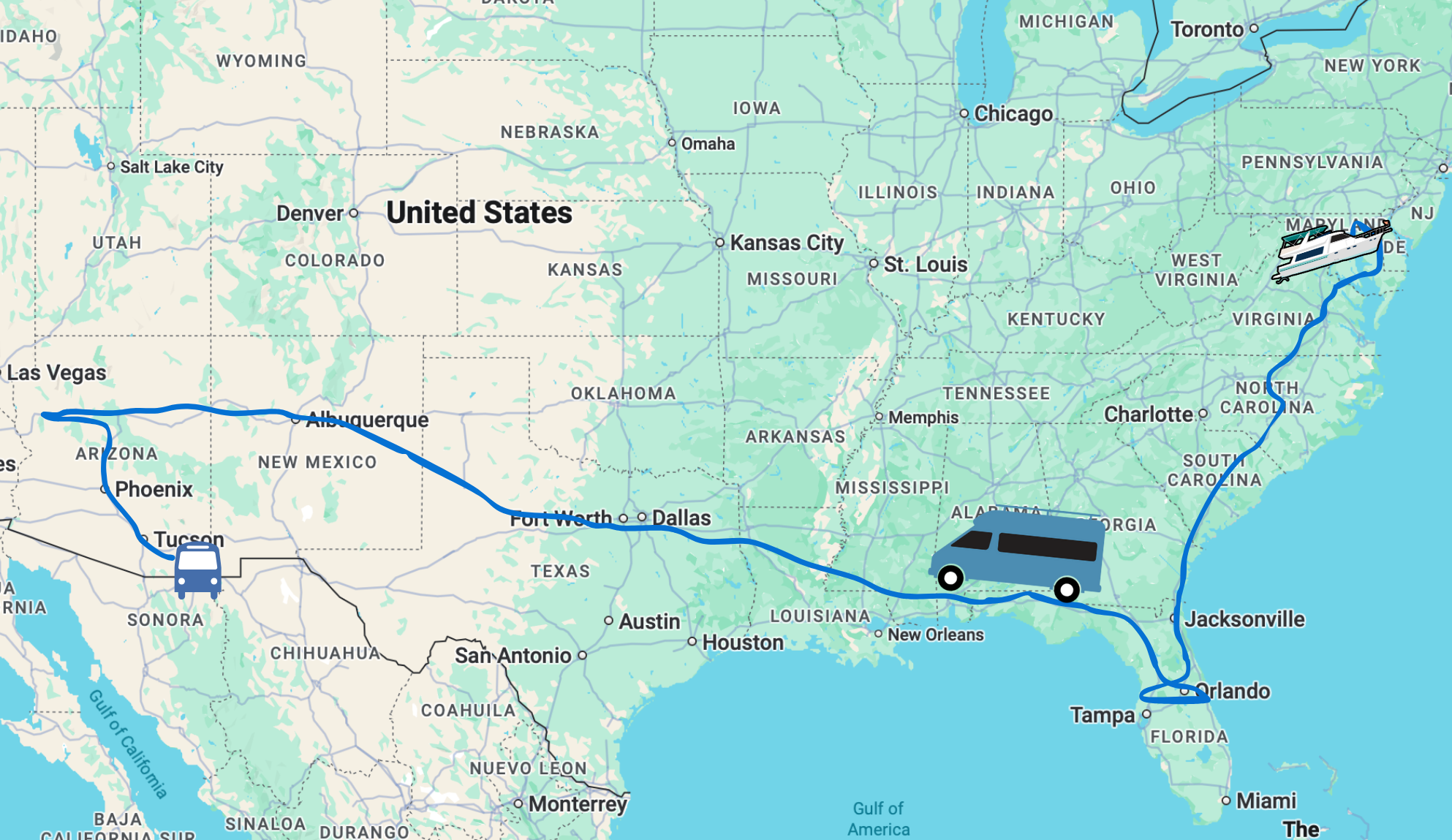
where is a good place to get single cell LiFePO4????
Check our main lithium page at : https://www.technomadia.com/lithium However, we’re not up to date on the current options, it’s been years since we shopped.
Hey you should give credit when you use someone work. Original content – http://www.powertechsystems.eu/en/technics/lithium-ion-battery-advantages/
Wow..they totally stole our content AND mis-credited it to ‘technomedia’. Thanks for alerting us, we’ll track them down and proceed with a take down of the content. We are the original source.
Thanks you so much for your help, we just bought an old and beatifull 1964 Airstream Tradewind.
We really want to build an exemplary hybrid solar eolic and propane generator electric system and we really apreciate your help.
we would know the best batteries model for that idea.
Manuel – We’ve shared all of our research in these posts here. To figure out the best options for your own install I suggest contacting some battery installers and/or distributors.
Cheers,
– Chris
I have been researching LFP for about a month. The problem that I dont see mentioned, (and it is the one that has kept me from pulling the trigger because I live in Alaska) is that the batteries can be damaged if you attempt to charge them in cold weather. I have a few ideas for ways around this like battery blankets run off the generator but you would have to disconnect the charging system before starting the Genset. One mistake and cost for my system, $3174.00 down the drain and who knows where I might be sitting when I make that screw up.
Love your articles very informative.
It actually is mentioned in other articles in this series 🙂
Indeed – many LFP cells can suffer damage if they are charged at more than a trickle while below freezing.
On paper – the LFP cells made with Yttrium seem to have much better low-temperature specs and can handle being charged even while extremely cold. The Winston (Yellow) cells sold by Balqon I believe incorporate Yttrium – I’m not sure about other makers, or if these low-temperature claims have been confirmed by independent long-term testing.
Definitely a challenge dealing with batteries in cold temperatures – even lead batteries have major issues to work around. Keeping the battery chamber heated to 35-degrees is probably the smartest move.
Good luck!
– Chris
We read quite a bit before we decided to use LFP with our solar system. Older son has been in solar business in 1991 (Energy Concepts in Las Vegas, NM) and wanted us to do full-time with solar. Original system in 2007 was 4 GM batteries, 2.5 kW PSW inverter and 400 watts of solar. This gradually increased to 700 W. Crunched 5th wheel and pickup in 70-car pileup 70 miles west of Vera Cruz. Cary was excited about solar/LFP combination and started design. He checked with Lithionics and Manzanita (both of which are interested in fabricating for RVs). He put the system on in June and we have not hooked into line power or generator since except for testing. Current system is:
1420 W of solar panels
Power comes from roof at 54 V nominal
4 x 14 V Manazanita battery packs in series (54 nominal V)to give 9.7 kW-hours of storage (720 amp-hours at 12 V nominal).
54 V goes to inverter (Magnum 4.0 kW PSW) and/or 12 V converter. E
Dumped 50 amp cables. Cary set system so that we can operate from 15 amp ac through battery chargers. We tested this for several hours at night to make sure it will operate the ac without battery drain (after startup).
We have operated the 1.5 kW ac of our Open Range 337 RLS for over three hours a number of times using solar/LFP battery combination. Elaine operated wicro-wave for an hour several days to defrost a large chicken and the solar just about kept up with this.
We did retain a small Honda gas 1.0 kW generator for backup if we are forced to camp with a lot of shade or travel through extended rainfall. This will provide 0.6 kW charging. We can generally get better than 0.4 kW even on extremely cloudy days. Of course, we get just about 0 if under heavy tree shading
This looks like an absolutely awesome setup Reed.
I love how you are using a higher voltage battery bank and inverter – that makes it easier to get away with much smaller battery wiring, and it allows for a relatively lighter and more efficient inverter too.
What solar controller are you using?
I will definitely love to compare notes with you and hear how your system performs over time – it is definitely one of the most impressive I have seen!
– Chris
Question… it’s now 2012… Some time since building your Lithium Battery Bank— I am in the Planning stages of Building a similar Battery Bank for extreme boon-docking with the 25ft Airstream and Purchasing Solar Panels.
Knowing what you know today with experience– what advice would you give me in building a Generator-Free Solar Energy System for my Travel Trailer?
Thomas
Hi Thomas –
Can’t think of anything specific to further impart at this time. Unfortunately, we’ve not had the opportunity to really put our bank to the paces, as we’ve been living pole-to-pole the last several months as we’ve shifted our focus to care taking for an ill loved one. Hopefully in the near term future we can get some off-grid time in and gain some more experience to report back. So for now.. our current experience is what is posted – our advice remains, this is all new territory and don’t attempt it if you’re not ready to take the financial risks and experimenting with new unproven stuff.
If you have specific questions, feel free to contact us directly.
As far as solar, we have only just begun to scratch the surface of our research for starting that project ourselves.
Keep tuned in, we’ll report as we have time and information to share.
– Cherie
I’m a salesman representing a medical panel PC requiring 12VDC@8.33Amps. I have a potential customer who would like to run this PC off battery/batteries eight hours each day. Looking for a potential battery solution for them (100 amp-hour?), I stumbled across your very cool website & enviable way of working viturally anywhere! I compliment you. Any advice for a battery/charging solution to help a customer? – Mike (PS: I’d really like to buy you two dinner & chat about your experiences should you ever be passing through Columbus, Ohio!)
I thought of you today when I saw lithium phosphate getting a little media love this week, with this Daily Tech story about GM’s use of the technology in the Spark EV:
http://www.dailytech.com/GM+Buys+Lithium+Phosphate+Batteries+for+Spark+EV/article23479.htm
Further research suggests that while A123 is working on a LiFePO4+C-based technology, their current technology is Lithium hexafluorophosphate based, or LiPF6. Not as interesting, but … thought I’d share regardless.
-jbn
So I finally read this article. lol
Very impressed w/ the space and weight savings! I look forward to seeing the price and novelty barriers coming down on this technology. Thanks for letting us watch your experiment in progress!
Great comment Michael as I look at my 4 year old “6V” Golf Cart batteries still going strong. Mounted in the rear on a shelf (safe! and covered with much ventilation…).
Very good write up. Technology has certainly given the Lithium batteries an edge over Lead Acid. BUT, then there is reality. When you look at bang-for-buck there are other things to consider. When you do, the lead acid battery is still a contender.
People will read this with stary eyes and miss little comments like;
1) One over charge and your thousand $$ batteries are ruined
2) There are no inverter/chargers to support this technology in RVs yet.
3) When one fails you certainly cannot stop at Walmart or Costco to replace it?
I think a few years from now when the support is there and the cost come down these will be “norm”. But until then unless you want to be one of the Guinny Pigs, I think I’ll stick with my lead acid setup.
One last comment…. To truly live off grid doesn’t mean to buy a massive battery system to survive. Remember, you have to charge that system too. Presently your money is better spend on getting lower wattage devices (LEDs for example) to reduce your dependance on power then design your battery bank. Don’t just put in 1,000 aH’s just because you can????
Again, great article and good research.
Michael Putz
Mesa, Az
78FC35 Wanderlodge
63FC35 Blue Bird
Great comments Michael – and very true indeed. Anyone considering Lithium Ion for a RV house battery bank needs to fully understand that this is pretty unchartered territory, and we are pioneers in some ways on using this technology for a RV house battery system. If one is not willing to take the risks and isn’t prepared to do a lot of the leg work and be intimately involved with their battery system, they should wait a few years for this to become mainstream. No doubt about that.
We are choosing this path very consciously, and took this on fully realizing all of the risks. As was clearly stated at the end of the article, we are not sharing to encourage others to replicate our system and follow suit. We have nothing to gain by that (other than others to commiserate with).
To truly live off grid doesn’t mean to buy a massive battery system to survive.
This is true, if one’s goal is simply to survive.
However, some of us are doing this to thrive.
We are technology professionals running quite an array of computers and tech that our livelihood & fully mobile life depends on. In the past, we’ve done ultra conservation by reducing our power needs down to running a string of LED lights and two laptops (we also had no plumbing, A/C or refrigeration in our little 16′ trailer). We’ve done our time with being ultra off grid & ultra off grid, and proved we could do it for extended amounts of time. Our new challenge is to create a very high tech, uber groovy, hyper mobile, home & office on wheels.
For us, we’re not putting in 500-1000 aHs just because we can, but because it’s the lifestyle we want. Being able to run my 30″ Apple Cinema display to get my job done while viewing always changing amazing office views, and keeping the cat cool in the middle of a desert? Totally worth it.
“In theory, there is no difference between ‘theory’ and ‘practice’. In practice… there is.” Yogi Berra.
Sorry, I couldn’t resist. I just discovered your blog. It’s great! Super informative article about the lithium batteries. Keep up the great work. I’ll be a regular. 8-D
I had also gone through your earlier article about lead acid batteries and found it interesting too. In this article you have explained the benefits of lithium Ion batteries in a wonderful way. Keeping the benefits in mind, price should not be a major factor.
Will keep up with this. For me the advantage would be that we are away from Base Camp at least 6 months a year. This water batteries, well, I have to have someone come once a month and check them out…
Thanks… Ara & Spirit
Excellent write-up (I agree w/ Eric about the lovely writing…both of you)! Looking forward to the $$ part next!
Nina
I’m considering the house battery system for my RTS conversion, and am reading this series with baited breath.
At this point, every option is expensive for me. But if I can find something that will work a lot better long term, I’d be more than willing to splurge now to save later.
Way over my head, but I did catch lighter and more dependable ….I think ….I hope. Yup, thats what you said. Sure, it was, I think. Looking forward to the REST of the story.
Great Info Chris. Thanks for sharing. It looks like you have done a ton of research. How you found some of your resources must of been a headache and lots of time. I have learned a lot from your blog.
Was using my VW Westy Camper Vanagon to live and travel the US in. My 2nd Battery never lasted long and want to upgrade to Lithium. Got excited when you started posting info on your battery upgrade.
My Van Exploded while driving down the road and I now have to replace that too.
Keep up the hard work. The Info you provide is benefiting us the reader!
TJ
Oh man this is great! We’re about to set forth on a year-long odyssey in our 35′ 5th wheel and my electrical system is in serious need of help. Don’t want to be dependent on the generator or shore power so I’m having visions of LiFePO4 dancing in my head. Ever since your shared the first glimpse of these babies on your flickr stream I have been on the edge of my seat. I only hope we can find the budget to get some of these in our coach. Do you plan on adding solar to the equation?
Thanks for hanging on 🙂 Yes, just as with our past two rigs – we will be doing solar, and the lithium was selected to be a foundation for that. That’s our next major upgrade project to tackle.
so what is the price for a set like you have to fit a 4106?
Stay tuned, desi – that’ll be in our next post in the series.
Hey Cherie, Chris is a helluva writer ! You should get him on here more often. Or maybe he has a really good editor ? 😉
Heh.. getting Chris to actually sit down and write takes a lot of prodding, convincing and ultimatums. So, afraid readers of Technomadia will just have to put up with my inferior writing.:)
We readers of Technomadia are very lucky to have both of your writing talents keeping us informed and entertained; and we especially appreciate the prodding and ultimatums. 😉 keep him writin Cherie, he’s on a roll !!
Thanks for the compliment.
The best stuff on this site is the stuff that has both of our fingerprints on it. This post is much better for the editing and suggestions Cherie put into it, and I provide editing and advice for a lot of her posts too.
While we are both naturally talented writers (and Cherie is naturally prolific too), we are at our best when we work together. *grin*